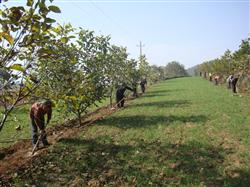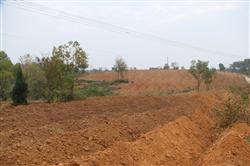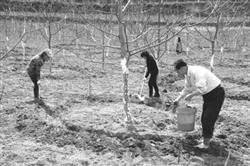How to manage walnut trees in autumn?

How to manage walnut trees in autumn? What do walnut trees need to pay attention to in autumn? Please introduce one by one that walnut trees consume a lot of nutrients during the fruit-bearing period due to the need of fruit. Fruit trees mostly show weakness of trees, obvious increase of diseases and insect pests, and even the structure of trees has changed. Therefore, walnut trees must be managed reasonably and effectively after fruit harvest, which can not only ensure faster recovery of tree potential, but also play an important role in preventing the occurrence of diseases and insect pests. The detailed management methods are as follows: dig the soil deeply after fruit harvest: the roots of walnut trees are generally deep into the soil, and whether the soil has good air permeability is directly related to the root growth. Therefore, after the fruit harvest, it is necessary to dig the orchard soil deeply. Liu Chaobin suggested that the deep ploughing should choose the right time. Generally, the orchard sundries should be cleaned up and the soil should be ploughed deeply from the fruit harvest to before the defoliation, and the deep ploughing should be controlled at 25cm to 40cm. "at this time, the temperature is relatively high, and it is also the second peak of root growth. Many injured roots are easy to heal and merge into new roots, and the soil nutrients transform quickly, which is conducive to the accumulation of tree nutrients." Liu Chaobin said. Rational fertilization combined with practice: at the same time, in the process of deep digging into the soil, rational fertilization should be carried out in combination with the reality of the orchard. Liu Chaobin said that the fertilization period should be controlled from early September to late October, that is, after walnut harvest. In order to ensure tree growth and fruit next year, fertilizers must be replenished in time and adequate nutrients must be provided. In this regard, Liu Chaobin suggested that fertilization should mainly choose organic fertilizer and biological bacterial fertilizer suitable for the growth of walnut trees, improve the soil, prevent hardening, promote air permeability, and add appropriate amounts of nitrogen, phosphorus, potassium and other medium and trace element fertilizers. "Walnut trees that bear fruit for the first time should choose high-quality organic fertilizer 30 jin, biological bacterial fertilizer 0.3 jin, nitrogen, phosphorus and potassium fertilizer 2 jin, Ciba boron and zinc trace element fertilizer 200 g / mu, and high-quality organic fertilizer 50 jin and biological bacterial fertilizer 0.5 jin per tree. Nitrogen, phosphorus and potassium fertilizer 4 jin, Ciba boron and zinc trace element fertilizer 300 g / mu." Liu Chaobin said: when applying fertilizer, it is necessary to spread fertilizer under the crown for the first fruit trees of 2 to 4 years old, and for trees of more than 5 years old, they can apply fertilizer in the ditch forward, mix the fertilizer and soil well and fill it back into the ditch, or alternately turn the tree tray after ditching and spreading. In addition, to cooperate with watering, generally deep turning or ditching fertilization should be timely and fully irrigated, and the soil can be irrigated again in dry years before freezing. Pruning needs to grasp the time and methods: walnut trees must grasp the appropriate time when pruning, generally dormant pruning is easy to cause bleeding and weaken the tree potential, and even cause local branches to die, therefore, it is best to control the pruning time before falling leaves in autumn or after sprouting in spring. "the pruning period from the Autumn Equinox to Cold Dew is the best, which is conducive to wound healing as soon as possible in the same year." Liu Chaobin said that if the pruning workload is large, it can also be pruned in the winter of 30 days after falling leaves-25 days before sprouting, which can reduce the adverse effects of bleeding on trees. On the basis of mastering the appropriate pruning time, the pruning method must also be appropriate. Liu Chaobin said: at the young stage of walnut trees, the nutrition is exuberant, the branches grow rapidly, and the crown expands year by year. At this time, attention should be paid to cultivating the trunk, keeping the main branches, retaining the auxiliary branches, thinning and dense branches, growing branches, and weak branches in time, leaving more fruiting branches in the crown, and pruning had better be combined with pulling branches, and the dense planting should be supplemented by pruning mainly by pulling branches. Liu Chaobin said that this pruning not only ensures that the main branches are evenly distributed and grows symmetrically, but also makes the crown clear, transparent and unbiased, ensures the balanced development of the tree potential, and gradually develops into a full tree with large fruit volume. Click to get more hickory planting techniques click to get more fruit planting techniques
- Prev

How to plant sweet peaches?
How to plant sweet peaches? Please introduce in detail the planting method of sweet peach, also known as red peach, is a kind of deciduous fruit tree, belonging to small and medium-sized fruit. In the case of no fruit thinning, the single fruit weight is about 100 grams. Artificial fruit thinning cultivation can increase the single fruit weight to 150 grams, and the maximum fruit weight can reach 250 grams. After trial planting in Guangdong.
- Next

How to manage walnut trees in autumn and winter?
How to manage walnut trees in autumn and winter? Please guide the management of walnut trees in autumn and winter, including soil, fertilizer, water management, pruning and anti-freezing. For detailed operation, you can refer to the following methods: soil, fertilizer and water management of walnut trees in autumn and winter: unfruited trees turn deep into the soil and build trees after falling leaves and before soil freezing.
Related
- Moge, come on! The staff of the peasant association in the producing area of cantaloupe were frightened when the crowd gathered.
- Causes and Solutions of low Fruit setting rate of Apple
- Symptoms and control measures of passion fruit virus disease
- Fruit growing lesson: how do apple orchards keep high yields?
- Can you build orchards in the mountains? What are the pros and cons?
- How to manage the coloring period of Crisson grape?
- This paper introduces the processing technology of two kinds of fig products.
- How much is a month for retired teachers in rural areas by 2020?
- How can strawberry planting increase sugar content? We should pay attention to management in many aspects.
- What are the cultivation techniques on how to improve the yield of golden fruit?

